read
Frédéric Blondy • piano
Thomas Lehn • analogue synthesizer
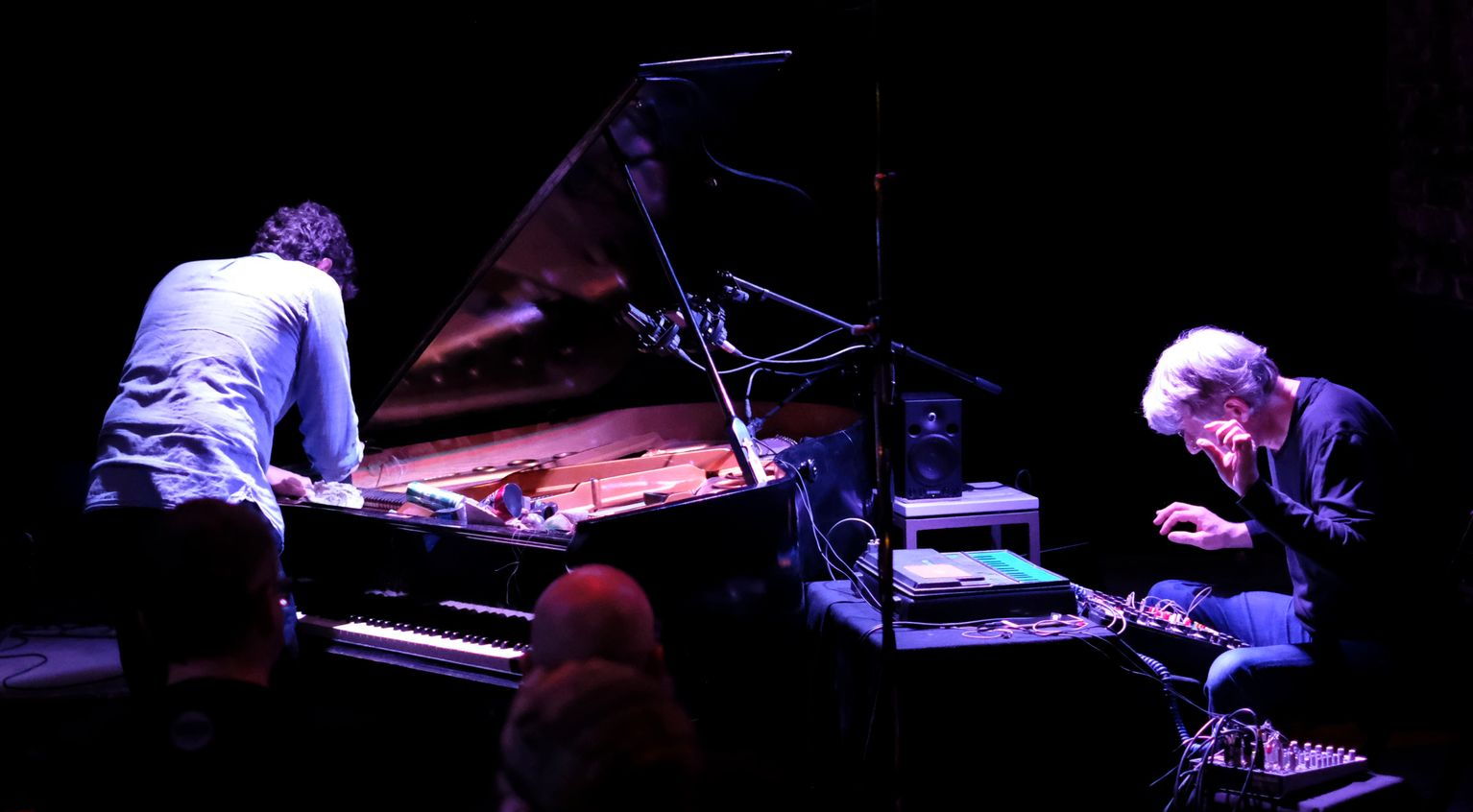
© 2022 free music forum / Corinne Studer
info | CD | reviews | links | press photos | tech rider
^
Frédéric Blondy • piano
Thomas Lehn • analogue synthesizer
Fréderic Blondy and Thomas Lehn gave their first performance during the festival Fruits de Mhere in France in summer 2001. Since then, they have been frequently working together as a duo. One major characteristic of their performance and music is a cross-effecting realtime sound processing by routing the piano audio signal into the analogue synthesiser's external input. The piano sounds are manipulated by the analogue synthesiser's modules (filters, reverberation, ringmodulation etc.). But simultaneously the incoming piano sounds are used as audio and control signals that interefere with and effect the synthesiser's sound synthesis.
CD
obdo
released 2008 on British label Another Timbre
at07
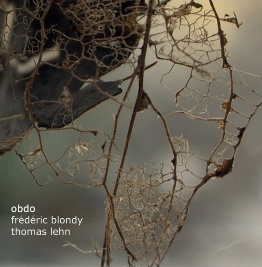
track listing
1. pooq (12:47)
2. obdo (37:00)
pooq consists of recordings in Bourogne and, at the beginning, an 80 second fragment of the Montreuil concert.
obdo is presented here
as it was performed at the festival Actes Temporaires in Périgueux,
except for some minor adjustments of dynamics, equalisation and stereo
image. Additional index points have been set for individual convenience
and do not indicate a subdivision of obdo into different parts.
Recording dates and locations
February 19, 2003, Instants Chavirés, Montreuil, France
February 12, 2006, Espace Gantner, Bourogne, France
July 9, 2004, Actes Temporaires, Périgueux, France
reviews
Frédéric Blondy / Thomas Lehn CD obdo
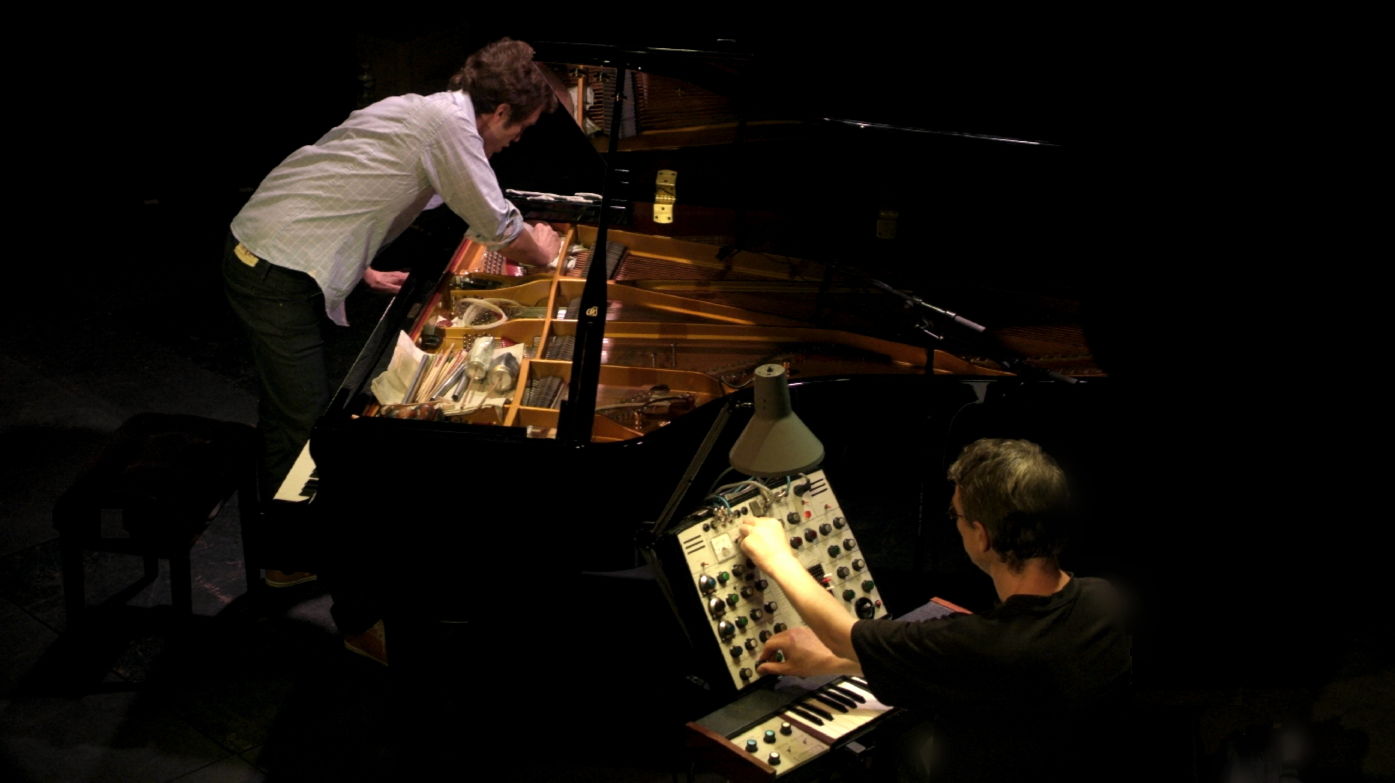
© Halousmen
^^
^
Thinking of this release as a duet between Frédéric Blondy and Thomas Lehn misses the mark completely. First there are the mechanics of the session. Blondy’s piano was routed in to external input of Lehn’s synth, providing sound sources which were manipulated in real time. At the same time, the input served as control signals that affected the sound synthesis. All of which was refracted back out for Blondy to respond to. Of course the technical setup would be of no consequence if the musicians didn’t connect so well. Both have extensive experience working in this space. Blondy is part of the group Hubbub, a quintet that turns two-reed, guitar, piano, and drums instrumentation into a setting for nuanced, chamber-like gradations of micro-details. And Lehn’s list of collaborations is mind-boggling. But in each case, he manages to inhabit the sound-space of his partners, from the hyper-kinetic Konk Pack to his participation in Mimeo.
Here, the two musicians mine the electro-acoustic palette of their combined instrument. While the low resonances and ringing sustain of the piano are filtered and fractured, the essence of the acoustic source is always present. Likewise, Lehn’s scribbled gestures and jagged textures are picked up by Blondy, with crashing chords, rumbling ostinatos, and percussive work inside the piano. The first piece was assembled by Lehn in the studio from two performances; the second piece is a live recording. Both are built around shadings of voicings and gesture along with the careful balance of dynamics and densities. Calligraphic electronics dart across piano thunder. Dark chords are turned in on themselves into roaring shards. Bright, sparely-voiced notes from the upper octaves are dropped against crackles and scratched synth. Particularly on the more extended length of the live title piece, the improvisation balances sections of spacious calm with heated squall with a thoughtful sense of overall form. This new label has been putting out a series of strong releases since its launch in late 2007. This is one of their strongest yet.
Michael Rosenstein | Signal to Noise
^
obdo’s two pieces derive from performances at French festivals by pianist Frédéric Blondy and analogue synthesiser player Thomas Lehn. The bulk of pooq was recorded in Bourogne in 2006 and subsequently modified in a process of audio editing that enhanced and added emphasis rather than substantially changing the material. On stage Blondy’s instrument was routed through Lehn’s synthesiser in a way that allowed reciprocal processing and interference to occur. The outcome might have been wild, even chaotic, but the duo prefer a highly restrained, subtle, even austere approach. Sparse, precise tones are tinged with reverb or gently swirled through ring modulation. Their interactive set-up reminds me of a suggestion by philosopher Michel Serres, in his musings on hosts and parasites, that something new arises only “by the injection of chance into the rule, by the introduction of law at the heart of disorder”. The longer title track was performed at the Actes Temporaires festival in Périgueux and received only minor adjustments later. This piece is far less like a cautious tightrope walk; the interaction is far more explicitly dramatic. Blondy works vigorously with the body of the piano, case and strings as well as keyboard. And Lehn is more intrusive, agitated and sometimes squally. The culmination is explosive.
Julian Cowley | The Wire
^
I know, maybe it's a cheap comparison, but sometimes, as a former comic book fan, all the combinations of impro musicians that follow each other in the various musical projects, make me think of those encounters-clashes, crossovers and various other things that infest the world of talking clouds, especially in the field of super heroes. And like there, sometimes there are pairings that say little or nothing, repeating tired routines, sometimes combinations that work small miracles. "obdo" falls into the last category. An unusual pair, pianist Frédéric Blondy, and the (perhaps) better known Thomas Lehn on analog synthesizer. Recorded live, but subjected to some slight form of post-production, in various French locations, the CD consists of only two tracks, pooq and obdo, and is based on a particular executive stratagem used by the two: the sound of the piano is given to the synthesizer to be manipulated and transformed in real time through the application of a series of filters of reverb, ring modulation, etc.. To further complicate things, the audio signal of the piano is also used as a control, more or less ... controlled, of the same activity of audio synthesis. Process, but not an end in itself, because the results are remarkable, to the point that I consider this CD the pinnacle of the current production of the Another Timbre label and the good taste of its founder Simon Reynell. The proceedings are spectacularly ghostly, largely quiet but imbued with a remarkable sense of drama, latent nervousness, a sense of danger, that feeling of uncertainty that you don't know what's stirring around the corner. Being able to recommend listening to it in total darkness, accomplice the excellent recording, which gives every sound, every gesture, a disruptive force, the darkness is the most suitable place to stage the mental dazzle and psychological excoriations of this music that deceives, subjugates, evokes ghosts, causes sudden and deep wounds.
Desolate and shrill sounds, probably the manipulated strings of the piano, introduce the first piece, to which is added the ominous pulse and alienating effects of Lehn. A few moments of permanence in a flickering grey zone and after it is all a succession of piano excursions by the Frenchman, a rich vocabulary of extended techniques, hints of clusters of notes almost Feldman-like, ruinous and dissonant falls, insistent shoring, and the admirable work of the synthesizer, which casts long and changing shadows.
Excellent, but the best is yet to come with the long title track. Here is staged an alienating game of mirrors, where everything is undefined, changeable, where strange life forms seem to materialize out of nowhere, first discreet, then noisy and intrusive, as if to claim vital space. The synthesizer is restless, creates obstacles and traps, while the piano, absolutely not normalized, seems almost a physical presence intent on disassembling and reassembling everything, except for some trembling meditative excursion. There are moments in which the tension reaches paroxysmal levels, close to collapse; saturation of nerves and emotions that finds its release valve in the last moments of the song. An insane and painful precipitate towards the void that swallows and destroys everything, leaving you completely speechless. Spectacular.
Alfio Castorina | Kathodik
^
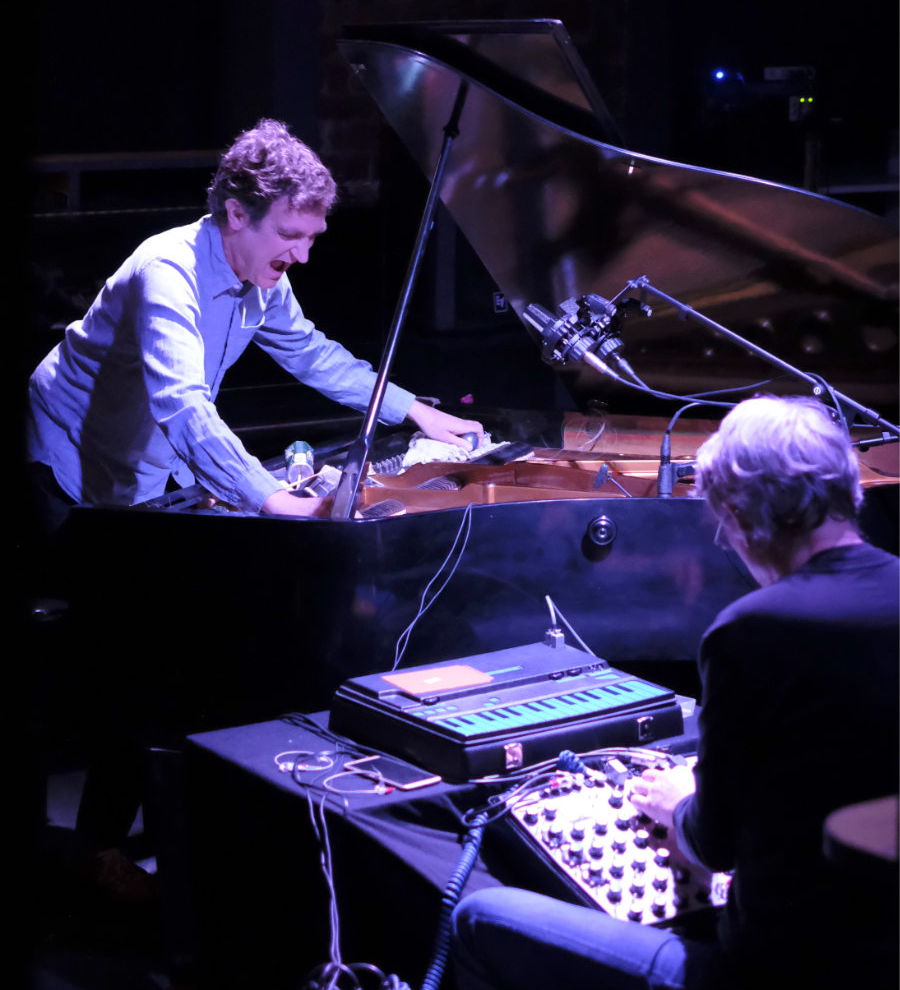
© 2022 free music forum / Corinne Studer
Thomas Lehn - whom we should remember trained as a pianist - and Frédéric Blondy form a duo of interacting keyboards, wires, strings and filters. For not only are the piano sounds treated by the synthesiser, but they themselves feed into and affect the synthesis. The dizzying possibilities of this situation could overwhelm, befuddle or intoxicate the musicians, but happily there’s nothing of that here. It is a drama of tension, of the play of timbres and spaces opening up landscapes which are diffracted and then shattered by delicate excavations or sudden orchestral squalls. For the listener this is a passionate journey through lands which rise up and then shift from moment to moment. On stage too this duo must be quite something.
Guillaume Tarche | Improjazz
^
Those who know the work of Frédéric Blondy and Thomas Lehn might expect a meeting of the two to be a kind of free-for-all in which speed is the primary parameter. But they will be surprised. In this recording there are no lyrical flights of fancy, nor shows of extravagant dexterity, as if both musicians are keen to avoid being caricatured. What is unique about this recording is the way in which the piano sounds are fed into the analogue synthesiser in such a way that they are not only manipulated but also themselves interfere with the process of synthesis. And while certainly active, the musicians let these technical processes play themselves out and be heard. At times they just listen to the (sometimes minute) transformations that they are effecting upon each other. We are invited not so much to listen to a dialogue as to explore the interior of a third space, the space of that almost immobile moment when the activity necessary for its survival is found in its deepest recesses. So this music takes time to build up and accumulate structures, which it then tramples down (though without hotheadedness) that same territory where it has become entrenched. Nonetheless there is a certain disequilibrium between the two musicians, with Thomas Lehn taking the initiative more as regards the sudden ruptures and other surprises which give life to the duo’s music. This cd will certainly delight all those like me, who love to be surprised by the richness of a soundworld which is both willed into being and allowed to run its course, and also moved by the musicianship of the playing (whether it is fast and furious or not).
Le Quan Ninh | Revue et Corrigée
^
Another fine one. On the first of two tracks the tendency is quiet (though often quite sharp), with Blondy vaguely evoking Tilbury in Cage/gamelan mode and Lehn contributing lovely mists, hammers and chirps. Much of the second piece is bumpier, more rambunctious, but sounds just as carefully considered. Wonderful, spatial clattering and dense, insane chittering in the second portion of the 'suite'. Excellent job.
Brian Olewnick | Just Outside
^
Thomas Lehn picks up the sounds produced on Blondy’s piano with his 'external input' and thus can do real time processing of the sounds using the filters, reverberation, ring modulation and what else such a machine offers. There are two pieces, the first and shorter one is an edit of various bits from a concert in Bourogne with a bit of a recording from Montreuil, whilst the second, title, piece is a straight recording from one concert, save for some minor adjustments. It's interesting to hear what editing could do here. In 'Pooq', things are kept highly 'silent' with just a few careful sounds. It sounds like the music was edited out, certainly if we compare it to 'Obdo', which is a much fuller piece, if not, at times, a noisy piece. The piano is scanned for all sorts of sound possibilities, hitting the keys, the body, the strings and together they weave an endless stream of sounds together, a pairing that goes wonderfully well together. A fine, thought-out work of improvisation.
Frans de Waard | Vital Weekly
^
obdo presents interactions of pianist Frédéric Blondy with Thomas Lehn, as they were heard on various French festival stages. Blondy taps, hammers, plucks and screws on the keys and strings, Lehn feeds his analogue synthesizer with these sounds, manipulates them, but only discreetly at first. As if Blondy's soup was too hot, he carefully blows what he is supposed to spoon out. Blondy plays only single notes, which he sometimes lets swing out or dryly muffles. The 37-minute title track was created in 2004 in Périgueux and is clearly more moving. Blondy rattles a chain in the inner piano and drones dark theatrical thunder; Lehn adds a fine pulse, mocking and hissing sounds that brightly contrast Blondy's rumblings. The notion of 'piano' has long since been thwarted, Blondy reworking the relic of bourgeois fluff percussively, noisily, conceivably unsophisticated, increasingly brusque. Not unromantic, if you count the Phantom of the Opera and the corpses in the basement as romantic. Lehn's Moog bubbles, trills and farts to it rather unrefinedly, even if he spreads his little finger ironically. But who would blush or even frown about that today? They get out of the way and that's that.
Rigobert Dittmann | Bad Alchemy #58
^
The duo of pianist Frédéric Blondy and synth manipulator Thomas Lehn holds a lot of potential. It's not often that synth is used alongside the piano, which is why I was turned onto this music in an instant. The fervour inside didn't diminish for a second when I learned the duo didn't simply play their instruments in real time alone. Both instruments were manipulated to give off the sounds included on this disc. Piano sounds that Blondy puts across were manipulated by Lehn's analogue synth's modules. Variety of filters, reverberations and ring modulations were concocted to come up with these rich sounds. To be fair, sounds of the piano were also used as pinnacle control signals that would budge and affect the sounds originating from the synth. To that effect, the first piece "Pooq" is the more serene of the two pieces included. It's as if the musicians were testing the waters, feeling the boundaries. Though their vision is all encompassing, it's not until we arrive at the thirty seven minute title track the duo breaks out of its collective shells and things really start to take shape. Blondy's mostly inside-piano work [tapping on the sides, caressing the strings, moving blocks across strings as well] is key impetus for Lehn to begin his radical work on the synth. The best sections are those when both musicians emulate a flock of squabbling birds, only to be dispersed with stark strikes of ivory keys accompanied with full-fletched glitch-ophony. Except for a few minutes of pure synth noise walls, the duo displays a large tendency for subtlety. It's in the quiet, contemplative moments, that the radical beauty of 'obdo' is found.
Tom Sekowski | Gaz-eta
^
pooq is composed from a number of recordings made between 2003 and 2006. Across its thirteen minutes both musicians explore the possibilities of the piano as a total instrument, including of course the use and manipulation of its inside as part of the sonic palette, mixing and transforming its sounds both organically and electronically. However silence appears as a central element within the piece. The result is thirteen minutes that achieve moments of almost paradoxical beauty. In contrast obdo is from the start much more frenetic than pooq. Howevere at its conclusion the intensity of the duo decreases and it picks up again the tranquil mood of the first track. Seen in its totality obdo creates across its 50 minutes a work which has a symmetry and logic underlying its almost overwhelming unfolding.
José Francisco Tapiz | Tomajazz
^
A unique mix of acoustic and electronic sounds made by two of Europe's brightest improvisers. The pianist Frédéric Blondy's play is transformed through the sound magician Thomas Lehn's analogue synthesizer, with extremely exciting results. The sound on these recordings is very measured and controlled, but always with a certain tension lurking under the surface. The music on this CD is not what you hear every day; it is very special and a demanding experience to listen through, but the result is excellent and exciting.
Henrik Kaldahl | Jazznet Denmark
^
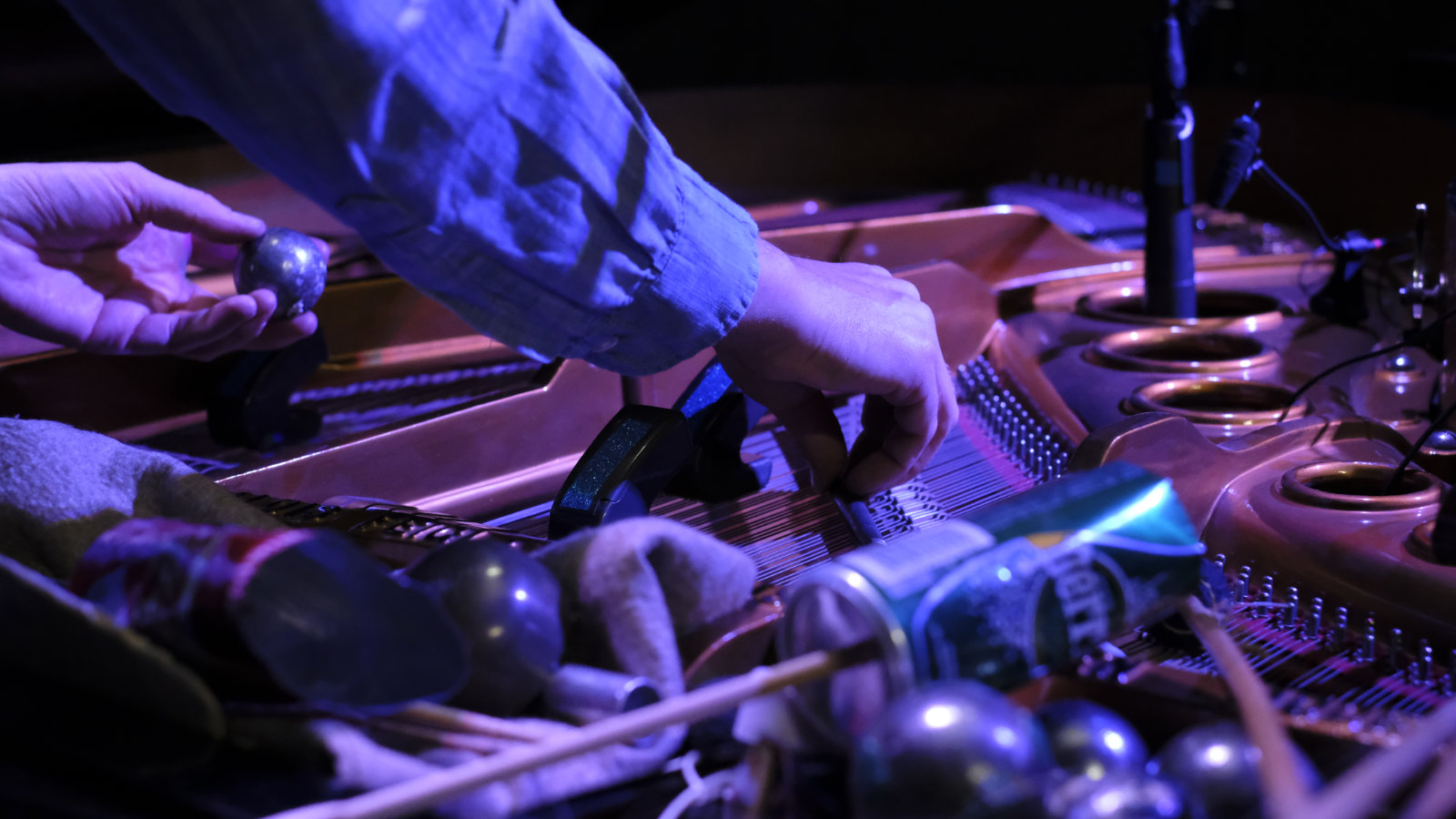
© 2022 free music forum / Corinne Studer
The basic method used by Blondy and Lehn for obdo is feeding the analogue synthesizer’s external input with the audio signal of the piano, thus obtaining what the liners call a “cross-effecting real time sound processing”. This means that what would normally constitute the typical features of a piano note - attack, sustain, decay, the dampened metallic qualities of the hammer-on-string processes - are heavily disfigured. OK, not always so massively, but certainly in a most unusual way. Apparently marginal phenomena, semi-distracted touches or quasi casual hits are captured by the modulating network of Lehn’s machine, portraying the worrying presence of some intruder who creeps behind your relaxed posture with silently threatening attitude, content with letting its blurred image be reflected in the mirror, the listener wide-eyed and open-eared to understand what’s going on. There’s no attempt to our security, though, the music mostly belonging to the “discomfort zone” where the instrumental lexicon privileges morphologies previously unheard of, totally excluding rosiness in favour of jangling impingements and unquiet modifications of the surrounding reality. The whole remaining on the “subdued” side for large chunks of the album, which only towards the conclusion of the title track brings out a quantity of repressed nervousness, the kind of “boiling inside” rage that ill-minded individuals disguise with affected smiles and fake goodness while intent in unsettling the life of someone perceived as superior to them. Lehn and Blondy seem to sonically portray exactly that feeling at the end, their conversation finally erupting in harsh contrasts and noisier parallelisms, enough to let us declare this CD as the most “concrete” - at least partially - in the already significant history of Simon Reynell’s imprint. Fascinating stuff, like in all the other chapters.
Massimo Ricci | Touching Extremes
^
Audio editing and shading expand the canvas on which French pianist Frédéric Blondy and German analogue synthesizer player Thomas Lehn aurally paint resonating variations on many themes here. Although timbres from Blondy’s keyboard are routed through the mechanism of Lehn’s contraption, the resulting shading, dynamics and spectralism still depend on the acoustic prowess and control of both musicians.
Seamlessly melding a fragment of an earlier concert into “Pooq”, the performance, is sonically multi-hued. Stopping and slapping his instrument’s internal strings, Blondy also alternates external key-picking and note-chiming. Eventually his emphasis on crystalline single notes is spatially underscored by Lehn’s triggered pulsations and driven vibrations
Recorded in real time, the three-part “Obdo” evenly matches contributions from the two, with neither destabilizing the concordance. Mallet-smacked and hand-stopped piano strings are amplified by the sound of marbles rolling within the piano mechanism, as concurrent synthesizer waves break up crackling static with hocketing tremolo tones.
Eventually Blondy’s multi-note improvisations reach a throbbing climax, seemingly scraping the finish off the strings as he plays. As these aggressive, high-frequency licks radiate outwards from the soundboard, Lehn’s chirping flanges and intermittent bursts of static solidify into fuzzy, sideband expansions. Joining with the pianist’s contrapuntal licks they subside into a satisfying diminuendo.
Each player has notably partnered in the past with such international sound explorers as saxophonist John Butcher and the band Konk Pack (Lehn) or percussionist Lę Quan Ninh and the Hubbub group (Blondy). On Obdo they confirm their mastery of the electro-acoustic duo with keyboards perfected in different centuries.
Ken Waxman | Jazzword/Musicworks
^
^^
^
DE
obdo bringt Interaktionen des Pianisten Frédéric Blondy mit Thomas Lehn zu Gehör, wie sie auf diversen französischen Festivalbühnen erklungen waren. Blondy klopft, hämmert, zupft und schraubt an den Tasten und Drähten, Lehn füttert mit diesen Klängen seinen Analogsynthesizer, manipuliert sie, allerdings zuerst nur dezent. Als ob Blondys Suppe zu heiß wäre, bläst er vorsichtig, was er da auslöffeln soll. Dabei spielt Blondy nur Einzeltöne, die er mal ausschwingen lässt oder trocken abdämpft. Das 37-min. Titelstuück entstand 2004 in Périgueux und ist deutlich bewegter. Blondy klappert mit einer Kette im Innenklavier und dongt dunklen Theaterdonner, Lehn legt einen feinen Puls dazu, spotzende und zischelnde Sounds, die Blondy's Rumoren hell kontrastieren. Die Vorstellung 'Piano' ist längst durchkreuzt, Blondy bearbeitet das Relikt bürgerlicher Flausen perkussiv, geräuschhaft, denkbar unbieder, zunehmend schroff. Nicht unromantisch, wenn man das Phantom der Oper und die Leichen im Keller zur Romantik zählt. Lehn's Moog blubbert, trillert und furzt dazu ziemlich unfein, auch wenn er dabei den kleinen Finger ironisch abspreizt. Aber wer würde heute noch darüber erröten oder auch nur die Stirn runzeln? Man geht sich aus dem Weg und damit hat sich‘s.
Rigobert Dittmann | Bad Alchemy #58
^^
^
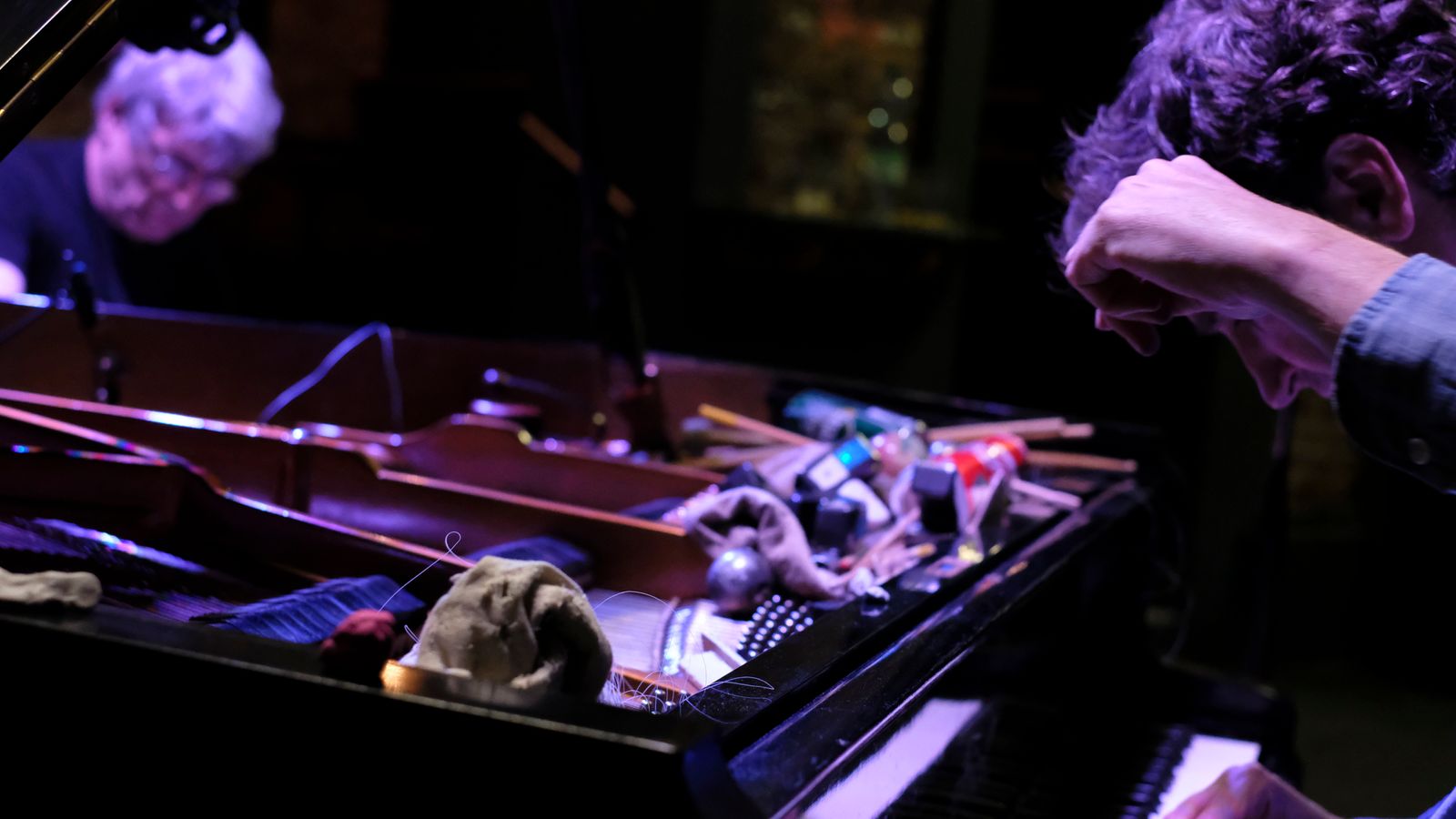
© 2022 free music forum / Corinne Studer
IT
Lo so, forse si tratta di un paragone tirato lě alla meno peggio, ma a volte, da ex appassionato di fumetti, tutte le combinazioni di musicisti impro che si susseguono nei vari progetti musicali, mi fanno un po’ pensare a quegli incontri-scontri, crossover e robe varie che infestano il mondo delle nuvole parlanti, specie in ambito super eroi. E come lě, a volte ci sono delle accoppiate che dicono poco o nulla, ripetendo stanche routines, a volte combinazioni che fanno piccoli miracoli. “obdo” ricade nell’ultima categoria. Una coppia insolita, il pianista Frédéric Blondy, e il (forse) piů noto Thomas Lehn al sintetizzatore analogico. Registrato dal vivo, ma sottoposto a qualche leggera forma di post-produzione, in varie locations francesi, il cd consta di sole due traccie, pooq e obdo, e si basa su un particolare stratagemma esecutivo utilizzato dai due: il suono del piano del piano viene dato in pasto al sintetizzatore per essere manipolato e trasformato in tempo reale attraverso l’applicazione di una serie di filtri di riverbero, ring modulation, ecc. A complicare ulteriormente le cose, il segnale audio del piano viene anche usato come controllo, piů o meno…controllato, della stessa attivitŕ di sintesi audio. Processo, ma non fine a se stesso, poiché i risultati sono notevolissimi, al punto che considero questo cd l’apice dell’attuale produzione della label Another Timbre e del buon gusto del suo fondatore Simon Reynell. Il procedere č spettacolarmente spettrale, in gran parte quieto ma impregnato di un notevole senso del dramma, di nervosismo latente, di senso del pericolo, di quella sensazione d’incertezza che non sai cosa si agita dietro l’angolo. Potendo consiglio di ascoltarlo nel buio piů totale, complice l’ottima registrazione, che conferisce ad ogni suono, ad ogni gesto, una forza dirompente, l’oscuritŕ č il luogo piů adatto per mettere in scena gli abbagli mentali e le escoriazioni psicologiche di questa musica che inganna, soggioga, evoca spettri, provoca improvvise e profonde ferite.
Suoni desolati e striduli, probabilmente le corde manipolate del piano, introducono il primo pezzo, a cui si aggiunge il pulsare minaccioso e gli effetti stranianti di Lehn. Qualche istante di permanenza in una tremolante zona grigia e dopo č tutto un alternarsi tra le escursioni pianistiche del francese, un nutrito vocabolario di extended techniques, accenni di grappoli di note quasi Feldmaniane, rovinose e dissonanti cadute, insistenti puntellamenti, e il mirabile lavorio al sintetizzatore, che misurato proietta lunghe e cangianti ombre.
Ottimo, ma il meglio deve ancora venire con la lunga title track. Qui va in scena uno straniante gioco di specchi, dove tutto č indefinito, mutevole, dove strane forme di vita sembrano come materializzarsi dal nulla, prima discrete, poi rumorose ed invadenti, quasi a reclamare spazio vitale. Il sintetizzatore, si agita irrequieto, crea ostacoli e piazza trappole, mentre il piano, assolutamente non normalizzato, sembra quasi una presenza fisica intenta a smontare e rimontare ogni cosa, salvo concedersi qualche tremante escursione meditabonda. Ci sono attimi in cui la tensione raggiunge livelli parossistici, prossimi al collasso; saturazione di nervi ed emozioni che trova la sua valvola di sfogo negli ultimi istanti del brano. Un folle e dolorosissimo precipitare verso il vuoto che inghiotte e distrugge tutto, lasciando completamente ammutoliti. Spettacolare.
Alfio Castorina | Kathodik
^
^^
^
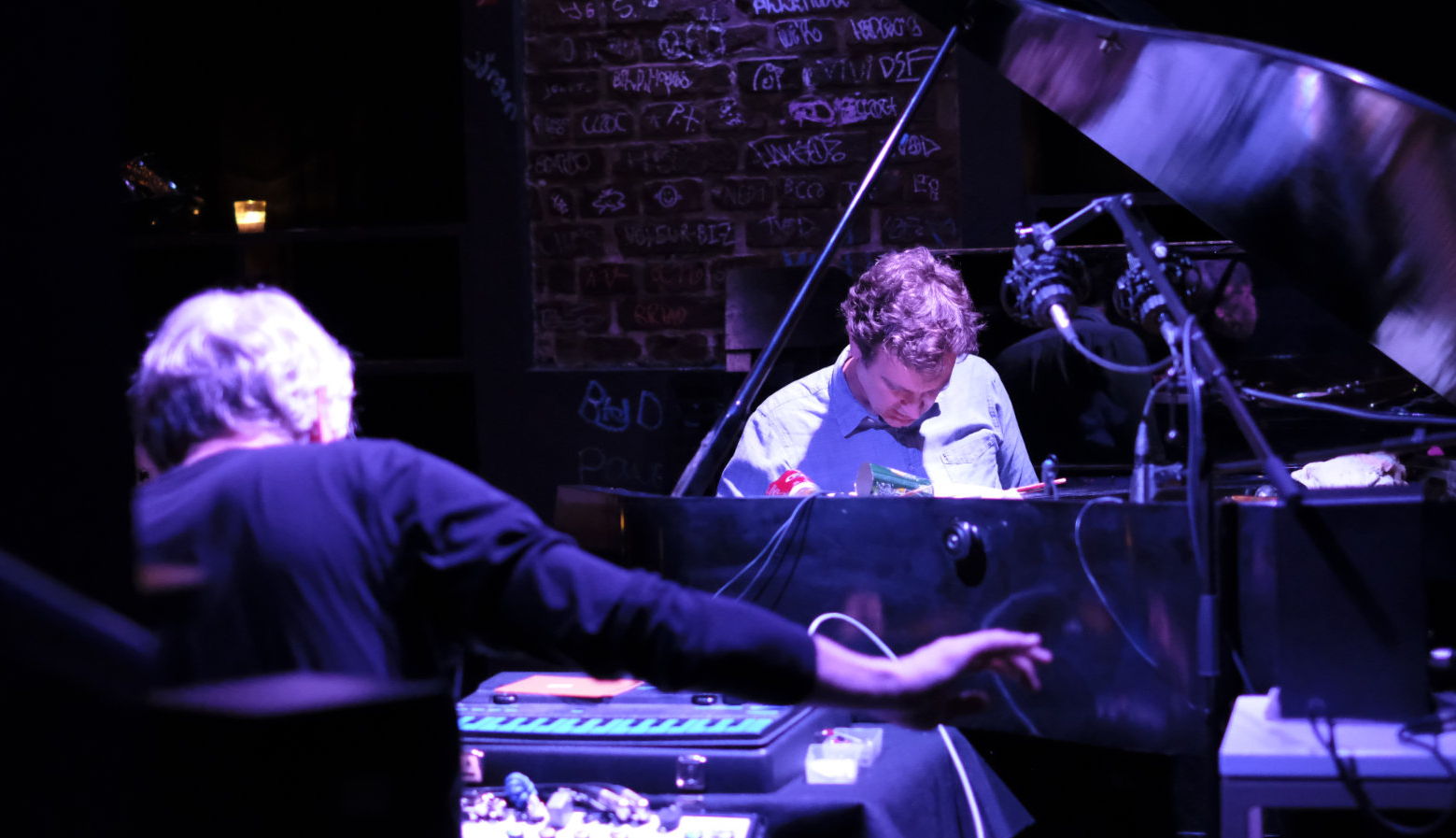
© 2022 free music forum / Corinne Studer
HU
Frédéric Blondy és Thomas Lehn kettőse nem siet, nem kapkod: a két zenész hét éve adta első közös koncertjét, bemutatkozó nagylemezükre mégis egészen mostanáig kellett várni. És ilyenkor szokták mondani: megérte. Megérte, ugyanis a sheffieldi székhelyű Another Timbre kiadó nem hogy katalógusának eddigi legizgalmasabb albumát, de könnyen lehet: a 2008-as esztendő egyik legélvezetesebb produkcióját szállította.
A Bordeaux-i születésű, jelenleg Párizsban élő Frédéric Blondy, valamint a fröndenbergi származású Thomas Lehn jól ismert hangszeresei a globális improvizásciós szcénának. Hosszú évek óta koncerteznek, készítenek lemezeket - ám kétségtelen: a mára csak analóg szintetizátorokkal kísérletező Lehnnek jóval több produkció írható a számlájára. Valóságos zenekarhalmozóként nincs olyan zenész, akivel ne játszott volna. Alkalmi duói és triói mellett talán leginkább a Konk Pack és Keith Rowe MIMEO-jának tagjaként ismert. Érdekesség: legutóbbi (és talán eddigi egyetlen) magyarországi fellépést a szegedi Jate Klubban abszolválta a harsonás Günter Christmann és a nagybőgős Alexander Frangenheim társaságában 1998-ban. Frédéric Blondy valamivel fiatalabb tagja a ma vezető zenei experimentalistáknak. A kilencvenes évek közepe óta koncertezik és készít albumokat kisebb-nagyobb csoportokkal, melyek közül számomra a Hubbub kvintett a legfigyelemreméltóbb.
Az Obdo lemez két darabja három koncertfelvételből áll. A rövidebb, Pooq névre keresztelt improvizáció 13 percét két francia fesztivál hanganyagából ollózták össze. Első blindre talán meglepő lehet, hogy a Bourugne-i és a Montreuil-i koncertet három esztendő választja el egymástól. A szerkesztési elv érdekes, hiszen - bár nem ismerem a teljes koncertfelvételeket - mintha pont a hangsúlyosabb zenei történések estek volna a vágások áldozatául. Ami megmaradt az halk és tétova. A Pooq tehát egy csendesebb darab: Blondy apró és erőtlen neszeket csihol zongorájának belsejéből - azaz többször érinti hangszerének belső húrjait, mint a billentyűket -, ezeket manipulálja Lehn valós időben. A zongora hangjai bizarr kicsengéseket, kifacsart visszhangokat kapnak - Lehn szintetizátora itt kizárólag Blondy zongorájának hangját használja külsű bemeneti jelként.
A korongot uraló Obdo már egy vágatlan, teljes koncertfelvétel, amit 2004 nyarán rögzítettek a Périgueux-i Actes Temporaires fesztiválon. A majd' 40 perces darab bár meglehetősen nehézkesen indul, végül jóval eseménydúsabb, hangosabb és persze kerekebb, mint az előző felvétel. A két zenész itt már nem finomkodik: előadásmódjuk, illetve a zongora és az analóg szintetizátor hangjai jóval szélesebb spektrumot járnak be - külön utakon. Hiszen Lehn itt már nemcsak Blondy zongorájának bejövő hangjait modulálja, hanem saját forrású zajokkal is dolgozik. A csend közeli pillanatoktól rövid út vezet a harsány zajig, és vissza. Jóleső csapongás, különös emelkedettség jellemzi a két zenész játékát.
Frédéric Blondy és Thomas Lehn kettősének produkciója amellett, hogy újabb szemléletes példája a tisztán akusztikus és elektronikus hangszerek ügyes párosításának, jóval több mint érdekes hallgatnivaló. Végre egy biztos kézzel, markánsan meghatározott zenei univerzum, amiben jó (meglepetéstől tátott szájjal) járni-kelni.
Dusted Hoffman | improv.hu
^
^^
^
links
Frédéric Blondy www.fredericblondy.net
obdo www.fredericblondy.net/disco/cdobdo.html
Another Timbre www.anothertimbre.com
^
updated on September 27, 2022